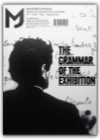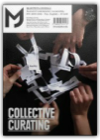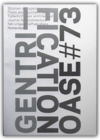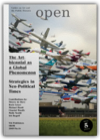|
Colors 컬러스 - 2012.가을

Colors 컬러스 78호 - 2010.가을 - Dance 춤

Colors 컬러스 79호 - 2010-2011.겨울 - Collector 수집가

Colors 컬러스 80호 - 2011.봄 - Superheroes 슈퍼히어로

Colors 컬러스 81호 - 2011.여름 - Transport: a survival guide 운송수단: 서바이벌 가이드

Colors 컬러스 82호 - 2011.가을

Colors 컬러스 83호 - 2012.봄

Colors 컬러스 85호 - 2012.겨울

Contemporary Art Journal 컨템포러리 아트 저널 2012 Vol.10

Contemporary Art Journal 컨템포러리 아트 저널 2012 Vol.11

Drawing Room Confessions #4: David Lamelas [Taschenbuch] by David Lamelas

E-flux Journal Reader 2009

This climate of disciplinary reconfiguration and geographic dispersal has made the art world a highly complex place the objective position that once defined the role of a critic has been effectively replaced by a need to understand just how large and varied the whole thing has become. The urgent task has now become to engage the new intellectual territories in a way that can revitalize the critical vocabulary of contemporary art. Perhaps the most productive way of doing this is through a fresh approach to the function of an art journal as something that situates the multitude of what is currently available, and makes that available back to the multitude. The selection of essays included in this book seeks to highlight an ongoing topical thread that ran throughout the first eight issues of e-flux journal a sequence of overlapping concerns passed on from one contribution to the next. Contributions by Michael Baers, Luis Camnitzer, Liam Gillick, Boris Groys, Tom Holert, Gean Moreno and Ernesto Oroza, Marion von Osten, Raqs Media Collective, Dieter Roelstraete, Irit Rogoff, Sean Snyder, Hito Steyerl and Monika Szewczyk. E-Flux Journal: Are You Working Too Much? Post-Fordism, Precarity, and the Labor of Art

E-Flux Journal: What is Contemporary Art?

The Exhibitionist no.1

FGA #29 - Italian Conversations: Art in the Age of Berlusconi

Going Public

Headache 헤드에이크 issue #0 - 창간호

Hito Steyerl - the Wretched of the Screen. E-flux Journal

How to Look At Art-Talk: How to Look At Aesthetics, How to Look At Capital

Manifesta Journal

Manifesta Journal 7 2009/2010 Grammar Of The Exhibition

Manifesta Journal 8: 2009/2010

Manifesta Journal 9 2009/2010

Manifesta Journal 11 2010/2011 Canon Of Curating

Manifesta Journal Vol 4, 5, 6

Mj Manifesta Journal: Ethics 12

NJP Reader: 예술인류학에의 기고 Contributions to an Artistic Anthropology

'The aim of the NJP Reader is to contextualize Nam June Paik's artistic thought and random access strategies in a topical discursive practice.' (Excerpt from the editorial on page 2) This issue presents selected responses of international artists, critics and curators to the following 3 questions posted in the form of a questionnaire: 1. Artistic anthropology intends to produce novel models of relationality and connectivity. Could (Nam June Paik’s legacy as a form of) artistic anthropology contribute to an artistic discourse going beyond the framework of “relational aesthetics”? What artists in our day have developed relevant examples of rethinking and recontextualizing an artistic anthropology? 2. What could artistic anthropology mean to current artistic practice? How could it relate to medium-specific qualities? Is it a form of artistic communication defined by a postmedium-condition? Or is it a practice demanding the concept of medium-specificity to change? 3. What could artistic anthropology - as a form of knowledge production - mean for the current classification system? Will it challenge the dominant paradigms of the established humanities and sciences? What type of new models might trigger this? How could artistic anthropology contribute to a better and more political understanding of the “human condition”? And what could artistic anthropology mean for the concept of art in general? OASE 73: Gentrification

Open 13: The Rise of the Informal Media

Open 16: The Art Biennial as a Global Phenomenon

도미노 DOMINO Vol.2 - 2012

디자인플럭스 저널 01 - 암중모색 상편

베르수스 Versus No.4 - 2011

볼 BOL 002 2006.봄 - 중동과 '우리'

볼 BOL 005 2007.봄 - 헐벗은 삶

볼 BOL 007 2007.겨울 - 베트남과 우리

아트인컬쳐 Art in Culture 2013.1

아티클 article 2013.1

아티클 article 2013.2

인문예술잡지 F 1호 - 재난, 2011

인문예술잡지 F 2호 - 예술가의 스테이트먼트, 2011

인문예술잡지 F 3호 - 공연예술특집, 2011

인문예술잡지 F 4호 - 예술 제도와 분배

인문예술잡지 F 5호 - 동시대성과 예술/부르디외를 읽자

인문예술잡지 F 6호 - 예술가의 프로그램

인문예술잡지 F 7호 - 과학적 상상력과 아방가르드

인문예술잡지 F 8호 - 토포스/사이트

|


Hyejin Jang
Collection Total:
848 아이템
848 아이템
Last Updated:
Apr 22, 2013
Apr 22, 2013
 Made with Delicious Library
Made with Delicious Library